Discover 35 hidden attractions, cool sights, and unusual things to do in Hanoi (Vietnam). Don't miss out on these must-see attractions: Vietnam Museum of Ethnology, Temple of Literature, and Presidential Palace. Also, be sure to include Hồ Hoàn Kiếm in your itinerary.
Below, you can find the list of the most amazing places you should visit in Hanoi (Hà Nội).
Table of Contents
Vietnam Museum of Ethnology
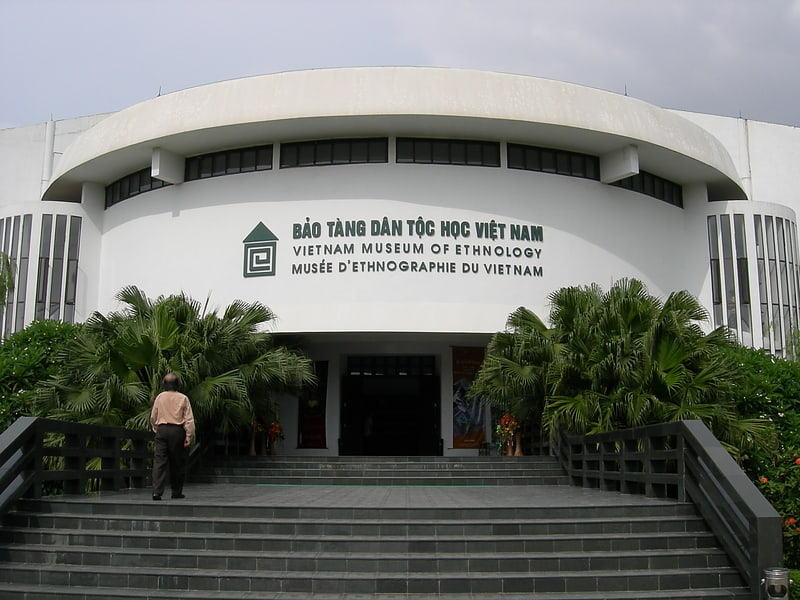
Also known as: Bảo tàng Dân tộc học Việt Nam
Large museum with cultural exhibitions. The Vietnam Museum of Ethnology is a museum in Hanoi, Vietnam, which focuses on the 54 officially recognised ethnic groups in Vietnam. It is located on a 43,799-square-metre property in the Cầu Giấy District, about 8 km from the city center. The Museum is a member of the Vietnam Academy of Social Sciences - an academic institution of the Vietnamese Government.
A second exhibition building was open in 2013 and has a focus on Southeast Asian cultures and peoples.[1]
Address: Nguyễn Văn Huyên, 100000 Cầu Giấy
Temple of Literature
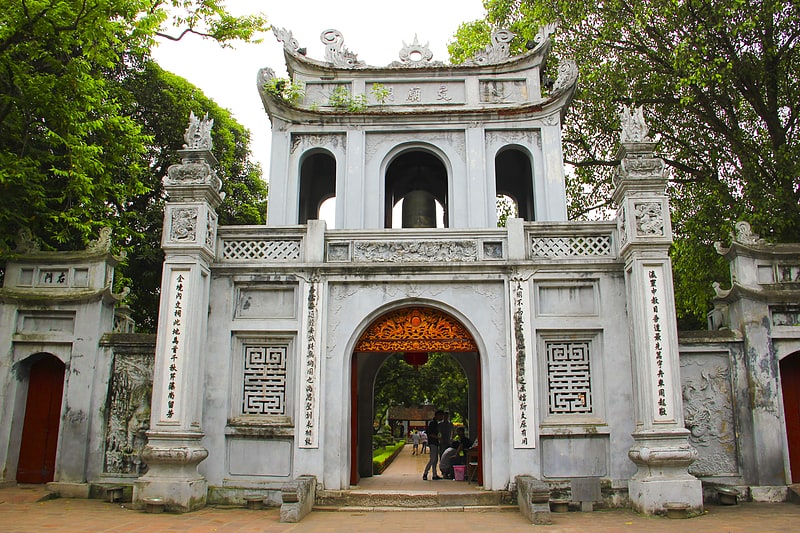
Also known as: Văn Miếu - Quốc Tử Giám
Temple in Hanoi, Vietnam. Văn Miếu is a temple dedicated to Confucius in Hanoi, northern Vietnam. The temple also hosts the Imperial Academy, Vietnam's first national university. The temple was built in 1070 at the time of Emperor Lý Thánh Tông. It is one of several temples in Vietnam which is dedicated to Confucius, sages and scholars. The temple is located to the south of the Imperial Citadel of Thăng Long. The various pavilions, halls, statues and stelae of doctors are places where offering ceremonies, study sessions and the strict exams of the Đại Việt took place. The temple is featured on the back of the 100,000 Vietnamese đồng banknote. Just before the Vietnamese New Year celebration Tết, calligraphists will assemble outside the temple and write wishes in Chữ Hán. The art works are given away as gifts or are used as home decorations for special occasions.[2]
Address: 58 Quốc Tử Giám, 100000 Đống Đa
Presidential Palace
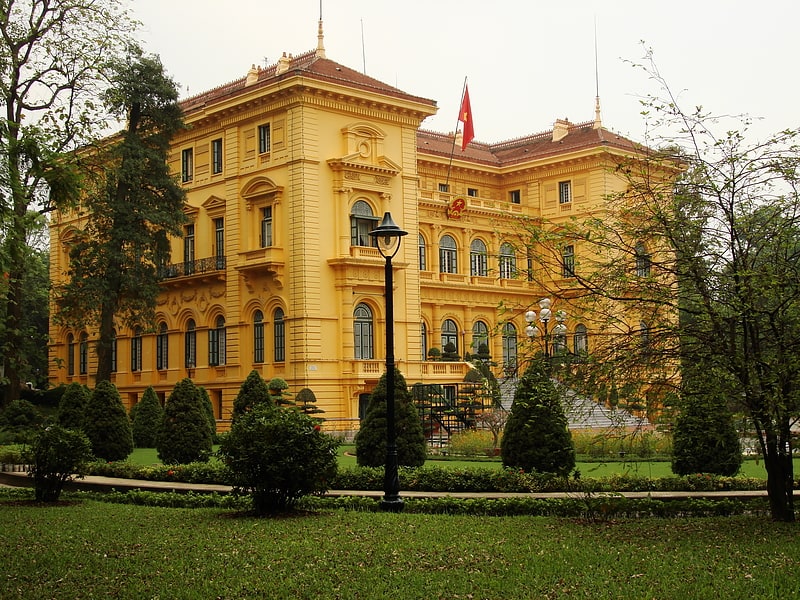
Also known as: Phủ Chủ tịch
French Colonial mansion from the 1900s. The Presidential Palace of Vietnam located in the city of Hanoi, was built between 1900 and 1906 to house the French Governor-General of Indochina.[3]
Address: Số 2 Hùng Vương, 118708 Ba Đình
Hồ Hoàn Kiếm
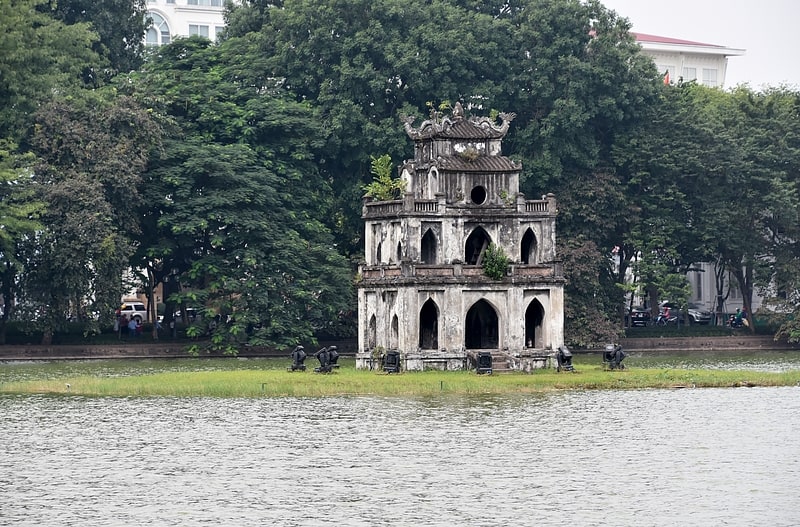
Lake with a temple, a bridge and a tower. Hoàn Kiếm Lake, also known as Sword Lake or Tả Vọng Lake, is a fresh water lake, measuring some 12 ha in the historical center of Hanoi, the capital city of Vietnam.
In the past, the lake was variously named "Luc Thuy Lake" (Vietnamese: Hồ Lục Thủy, meaning "Green Water Lake" - aptly named for the water's color) or "Thuy Quan Lake" (Vietnamese: Hồ Thủy Quân, meaning "Mariner's Lake"). The lake is one of the major scenic spots in the city and serves as a focal point for its public life.[4]
Address: Đinh Tiên Hoàng, Hà Nội, Hồ Hoàn Kiếm, Hanoi
Ho Chi Minh Mausoleum
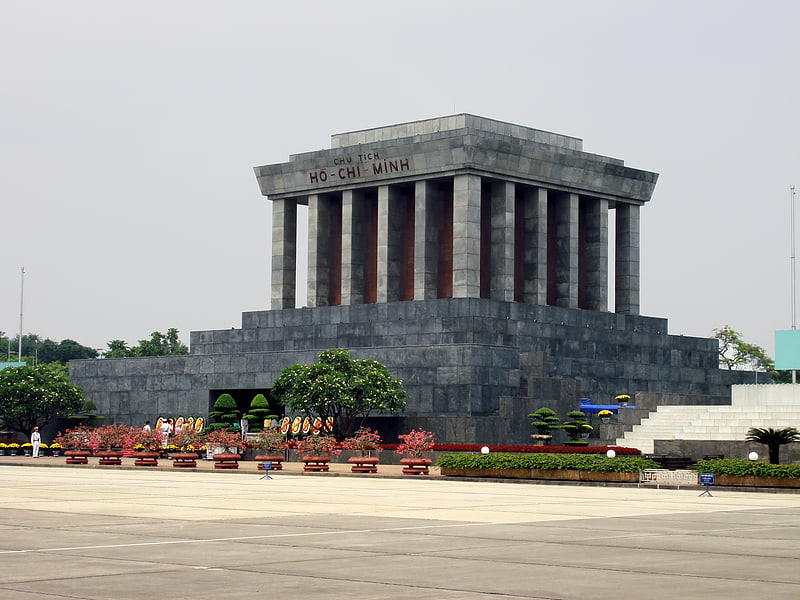
Also known as: Lăng Chủ tịch Hồ Chí Minh
Final resting place for Ho Chi Minh. The President Ho Chi Minh Mausoleum is a mausoleum which serves as the resting place of Vietnamese Revolutionary leader and President Ho Chi Minh in Hanoi, Vietnam. It is a large building located in the center of Ba Dinh Square, where Ho, Chairman of the Workers' Party of Vietnam from 1951 until his death in 1969, read the Declaration of Independence on 2 September 1945, establishing the Democratic Republic of Vietnam. It is open to the public.[5]
Address: 2 Hùng Vương, 100000 Ba Đình
Turtle Tower
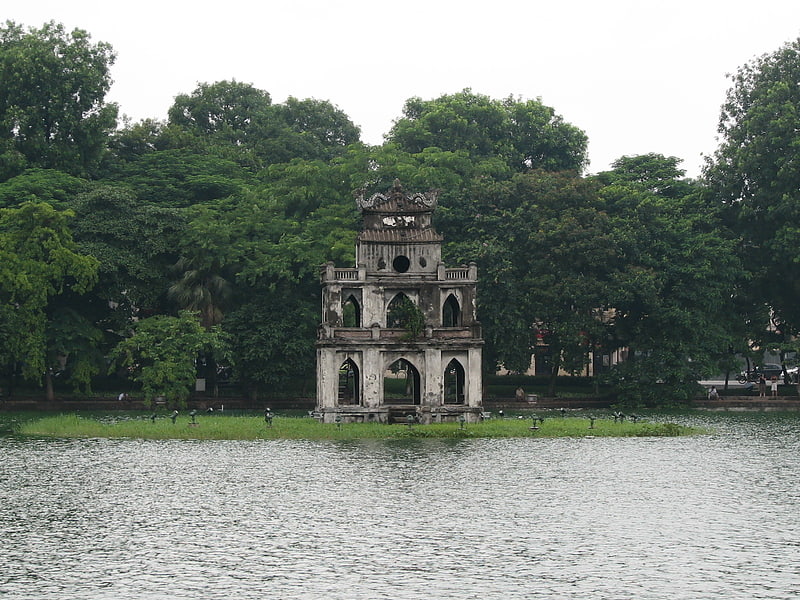
Also known as: Tháp Rùa
Historic tower on a scenic city lake. Turtle Tower, also called Tortoise Tower is a small tower in the middle of Hoan Kiem Lake in central Hanoi, Vietnam.[6]
Address: Hoan Kiem Lake, Hanoi
Vietnam Military History Museum

Also known as: Bảo tàng Lịch sử Quân sự Việt Nam
Museum of national military history. The Vietnam Military History Museum, set up on 17 July 1956, is one of seven national museums in Vietnam. It covers 12,800 m2. It is situated in central Hanoi, opposite the Lenin Park and near the Ho Chi Minh Mausoleum. The Flag Tower of Hanoi is located inside of the museum grounds.[7]
Address: 28A Dien Bien Phu St., 10000 Hanoi
Đồng Xuân Market

Also known as: Chợ Đồng Xuân
Sprawling standby for wholesale shopping. Đồng Xuân Market is a market in the center district Hoàn Kiếm of Hanoi, Vietnam. Originally built by the French administration in 1889, Đồng Xuân Market has been renovated several times with the latest in 1994 after a fire which almost destroyed the market. Nowadays, Đồng Xuân Market is the largest covered market of Hanoi where the wholesale traders sell everything from clothes, household goods to foodstuffs.[8]
Address: Dong Xuan and Hang Chieu Sts., 10000 Hanoi
Vietnamese Women's Museum

Also known as: Bảo tàng Phụ nữ Việt Nam
Museum in Hanoi, Vietnam. Established and operated by the Vietnam Women’s Union, the Vietnamese Women’s Museum officially opened its doors to public in 1995. The four-storey building is in Hanoi, Ly Thuong Kiet Street, situated along the central Hoan Kiem Lake and old quarter. It underwent renovation between 2006 and 2010. It functions as a gender museum and research centre that provides knowledge on the historical and cultural heritage of Vietnamese women among the nation’s 54 ethnic communities. By featuring women as its central theme, it illuminates the significant roles and contributions of Vietnamese women in the historical and cultural development of Vietnam. The museum also provides a platform for intercultural exchanges to occur between women in Vietnam and global societies, with the goal of fostering “equality, development and peace.” The museum consists of three permanent exhibitions: Women in Family, Women in History and Women’s Fashion. The permanent exhibitions feature more than 1000 materials, photographs and artifacts that describe the roles of Vietnamese women in the nation’s history and contemporary society The museum also organises thematic exhibitions to showcase transformations and new developments that occur in contemporary Vietnam. The museum’s key mission is “to enhance public knowledge and understanding of history and cultural heritage of Vietnamese women…thus contributing to promoting gender equality.”[9]
Address: 36 Ly Thuong Kiet, 100000 Hanoi
Vietnam People's Air Force Museum
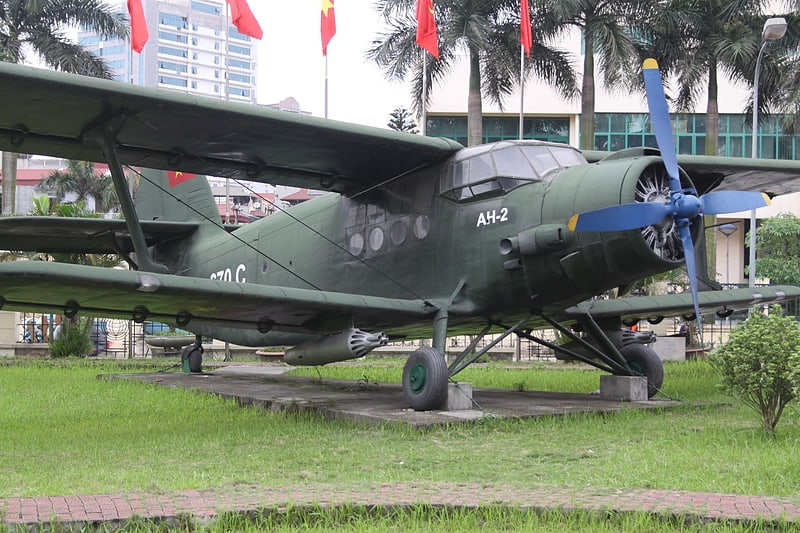
Museum. The Vietnam People's Air Force Museum, Hanoi or Bảo Tàng Phòng Không - Không Quân is located on Truong Chinh Street in the Bach Mai District of Hanoi. The museum is on the edge of the disused Bach Mai Airfield.
The museum tells the history of the Vietnam People's Air Force (VPAF) from its formation in 1954 through to the present day. There is a heavy emphasis on its role in the Second Indochina War and the Cambodian-Vietnamese War. The museum comprises one main building with displays on the history of the VPAF, biographies of VPAF aces, uniforms and flightsuits, aircraft weaponry and engines, items from downed US aircraft and the forward fuselage of a MiG-21. Outside is a static park with aircraft of the VPAF and the Republic of Vietnam Air Force.
The museum is open Mon.-Thurs. and Sat.-Sun. from 08:00 to 11:00 and 13:00 to 16:00. Entry fee is 20,000 VND[10]
Address: Truong Chinh Street, Hanoi
Hong River Delta
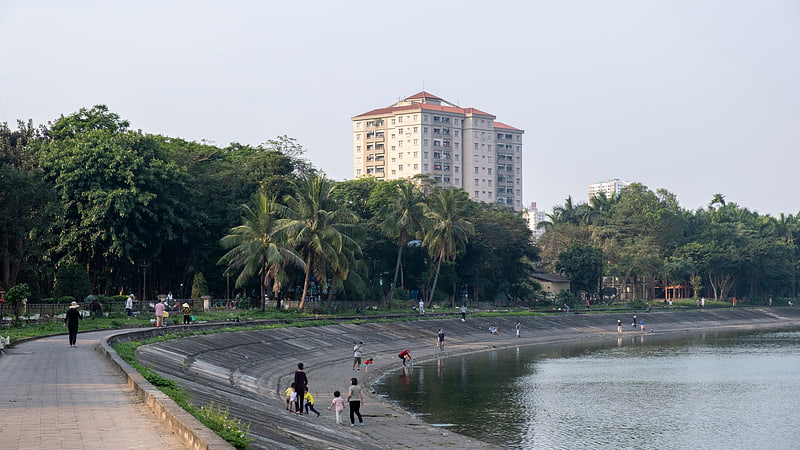
Region in Vietnam. The Red River Delta or Hong River Delta is the flat low-lying plain formed by the Red River and its distributaries merging with the Thái Bình River in northern Vietnam. Hồng is a Sino-Vietnamese word for "red" or "crimson." The delta has the smallest area but highest population and population density of all regions. The region, measuring some 15,000 square kilometres is well protected by a network of dikes. It is an agriculturally rich and densely populated area. Most of the land is devoted to rice cultivation.
Eight provinces together with two municipalities, the capital Hanoi, and the port Haiphong form the delta. It has a population of almost 23 million in 2019.
In 2021, Paul Sidwell proposed that the locus of Proto-Austroasiatic languages was in this area about 4,000-4,500 years before present. The Hong River Delta is the cradle of the Vietnamese nation. Water puppetry originated in the rice paddies here. The region was bombed by United States warplanes during the Vietnam War. The region was designated as the Red River Delta Biosphere Reserve as part of UNESCO's Man and the Biosphere Programme in 2004.[11]
Address: 18 Lương Văn Can, Hanoi
One Pillar Pagoda
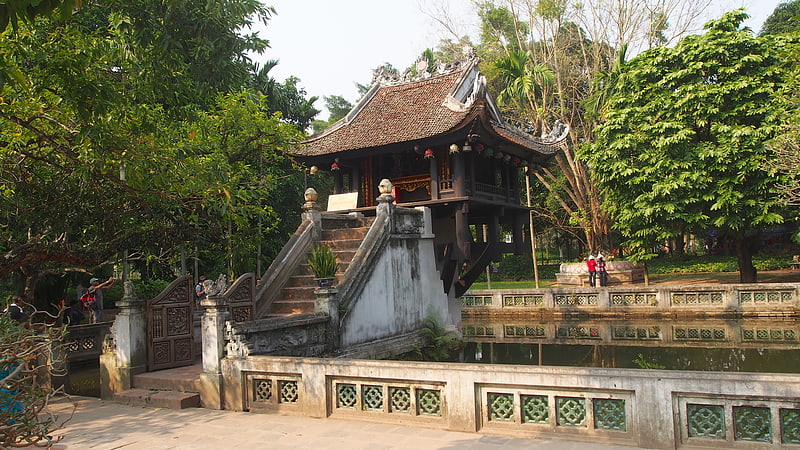
Also known as: Chùa Một Cột
Reconstructed ancient Buddhist temple. The One Pillar Pagoda, formally belongs to an architecture complex called Diên Hựu tự which means Extend Bless pagoda. The pagoda is a historic Buddhist temple in the central Ba Đình district, Hanoi, the capital of Vietnam. The most famous part of this architecture complex is Liên Hoa Đài which is a temple with special structure: a building laid on one pillar. The original pagoda was built in 1049, had some additions and was perfected in 1105. It is regarded alongside the Perfume Temple, as one of Vietnam's two most iconic temples.[12]
Address: Chùa Một Cột, Hanoi
Hanoi Citadel
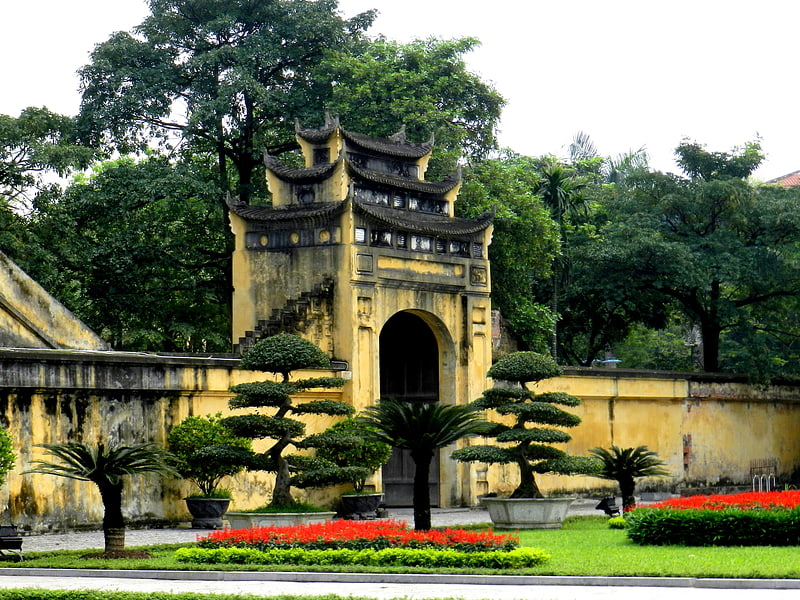
Also known as: Hoàng thành Thăng Long
Imperial citadel from the 11th century. The Imperial Citadel of Thăng Long is a complex of historic imperial buildings located in the centre of Hanoi, Vietnam. It was first constructed in 1011 under the reign of Emperor Lý Thái Tổ of Lý dynasty.[13]
West Lake
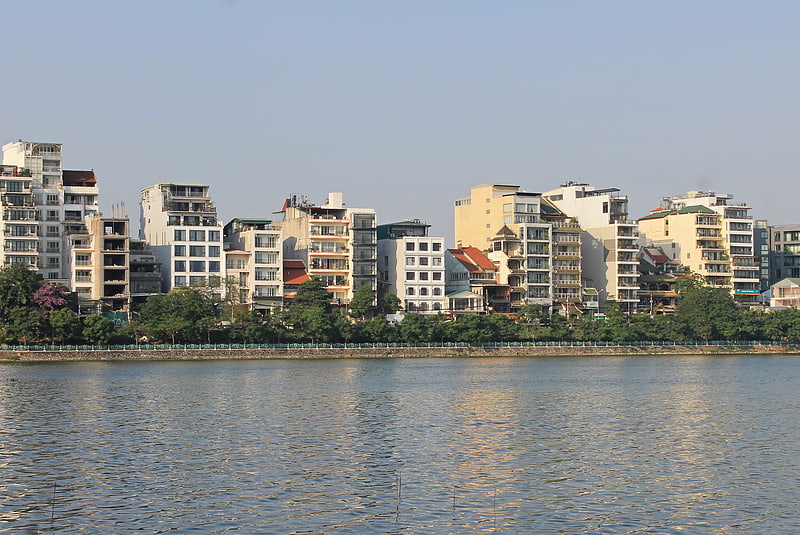
Also known as: Hồ Tây
Lake in Vietnam. West Lake is the biggest freshwater lake of Hanoi, Vietnam, located northwest of the city center. With a shore length of 17 km and 500 hectare in area, this is the largest lake of the capital and a popular place for recreation with many surrounding gardens, hotels and villas. A small part of West Lake is divided by Thanh Nien road to form Trúc Bạch Lake. Most of the lake is located within Tây Hồ District, named after the lake.[14]
Long Biên Bridge
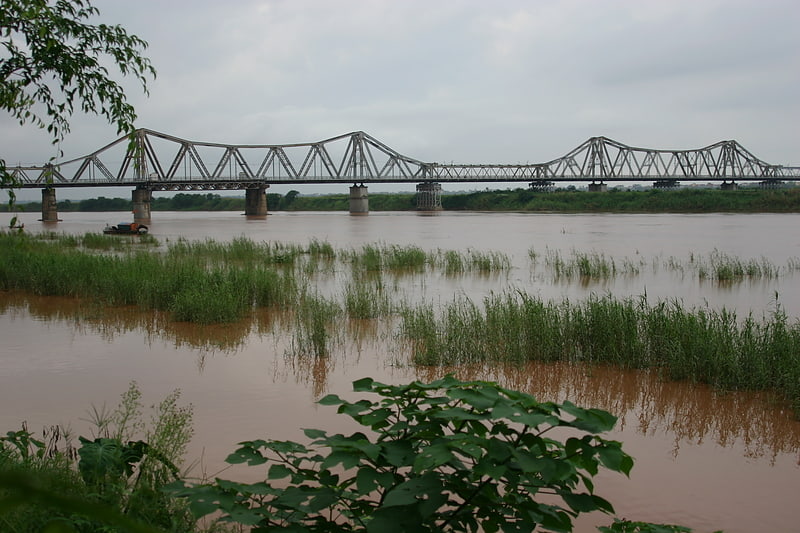
Also known as: Cầu Long Biên
Cantilever bridge. Long Biên Bridge is a historic cantilever bridge across the Red River that connects two districts, Hoan Kiem and Long Bien of the city of Hanoi, Vietnam. It was originally called Paul Doumer Bridge.[15]
Hanoi Opera House
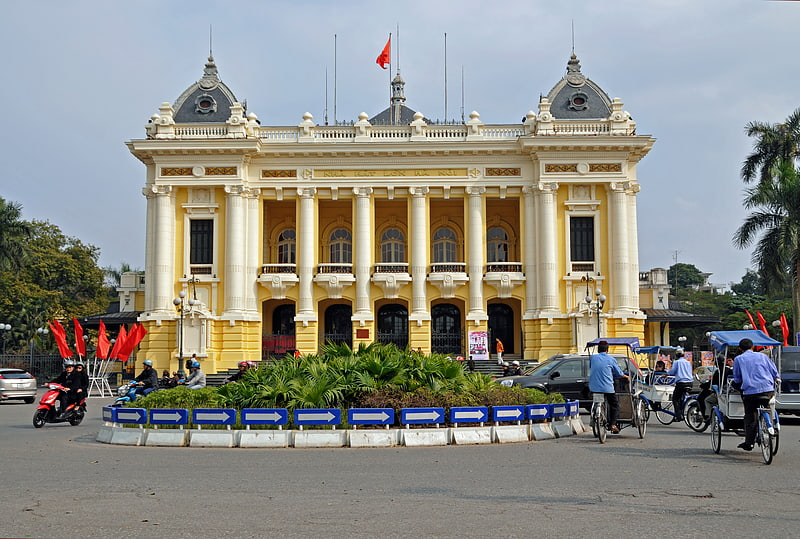
Also known as: Nhà hát Lớn Hà Nội
Grand classical music hall built in 1911. The Hanoi Opera House, or the Grand Opera House is an opera house in central Hanoi, Vietnam. It was erected by the French colonial administration between 1901 and 1911. Hanoi Opera House is one of three opera houses that the French built during their time in Indochina, the others are Haiphong Opera House and Municipal Theatre in Ho Chi Minh city.[16]
Address: 1 Trang Tien Street, 10000 Hanoi
Đền Ngọc Sơn
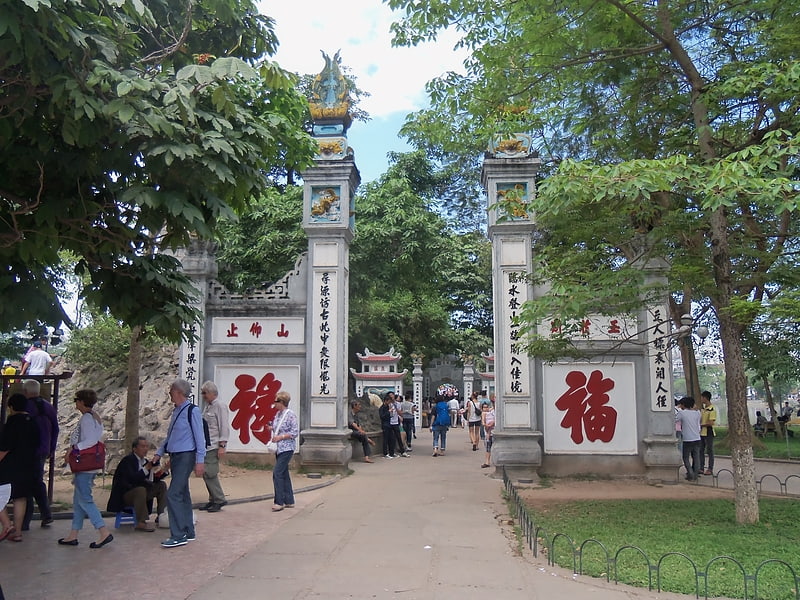
Temple in Hanoi, Vietnam. The Temple of the Jade Mountain is located on the Jade Islet in Hoàn Kiếm Lake, central Hanoi, Vietnam.[17]
Address: Dinh Tien Hoang St., 100000 Hanoi
Đền Quán Thánh
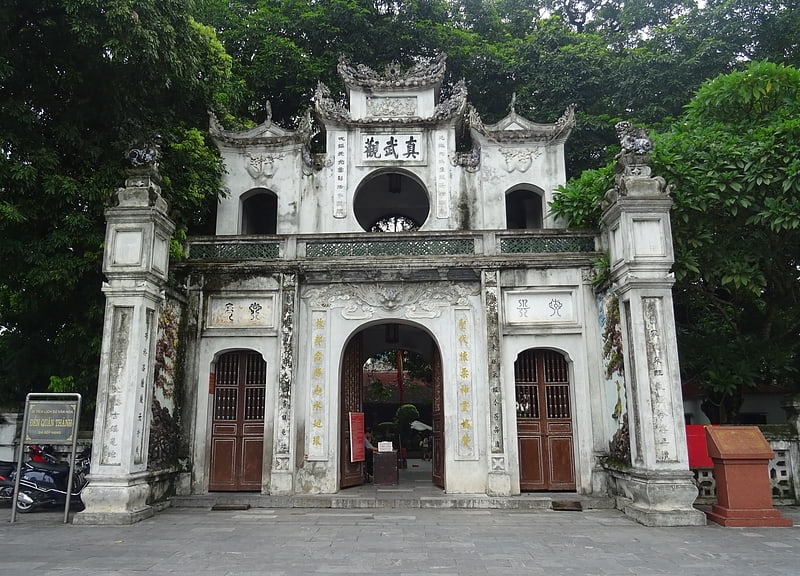
11th-century temple with a large statue. Quán Thánh Temple, formerly known as Trấn Vũ Temple, is a Taoist temple in Hanoi, Vietnam. Dated to the 11th century, the temple was dedicated to Xuan Wu, or Trấn Vũ in Vietnamese, one of the principal deities in Taoism. As one of the Four Sacred Temples of the capital, Quan Thánh Temple is located near West Lake in a ward of the same name: Quán Thánh Ward; and is one of the leading tourist attractions in Hanoi. The temple's name means Place of the Gods. The name of the long street running by the temple is also called 'Quán Thánh' street.[18]
Address: Thanh Nien Street, 100000 Hanoi
Chùa Trấn Quốc
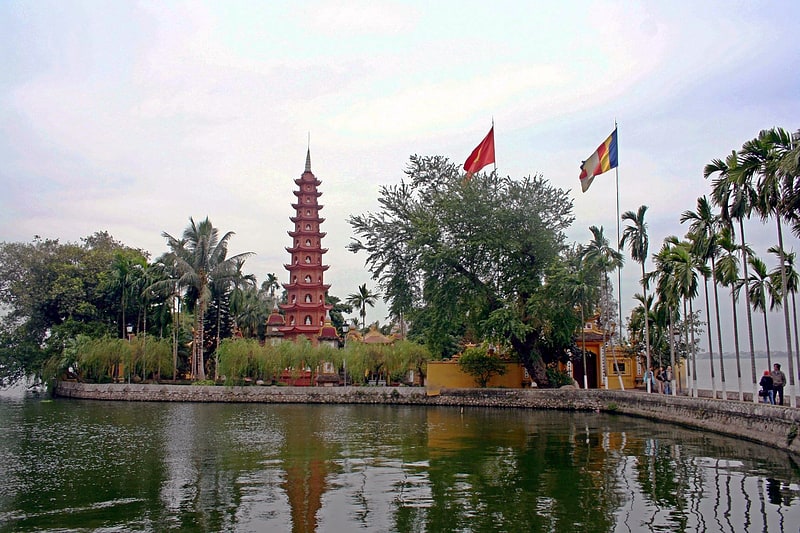
Ancient Buddhist temple in peaceful digs. Trấn Quốc Pagoda, the oldest Buddhist temple in Hanoi, is located on a small island near the southeastern shore of Hanoi's West Lake, Vietnam.[19]
Address: Thanh Nien, 10000 Hanoi
Ba Đình Square
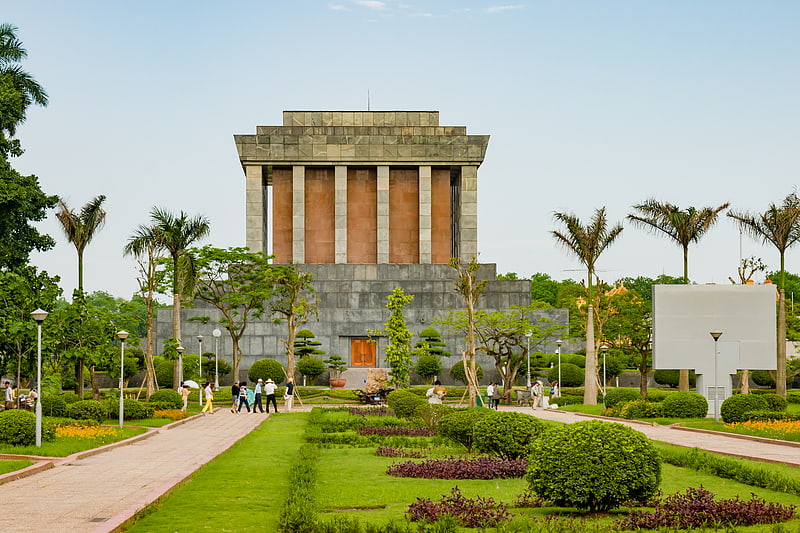
Also known as: Quảng trường Ba Đình
Historic square with Ho Chi Minh's tomb. Ba Đình Square is the name of a square in Hanoi where president Ho Chi Minh read the Proclamation of Independence of the Democratic Republic of Vietnam on September 2, 1945. It is named after the Ba Đình Uprising, an anti-French rebellion that occurred in Vietnam in 1886–1887 as part of the Cần Vương movement. When Ho Chi Minh died, the granite Ho Chi Minh Mausoleum was built here to display his embalmed body. It remains a major site of tourism and pilgrimage.
Ba Dinh Square is in the center of Ba Đình District, with several important buildings located around it, including the President's Palace, the Ministry of Foreign Affairs, the Ministry of Planning and Investment, and the National Assembly Building.[20]
Address: Ba Đình, Hanoi
National Museum of Vietnamese History
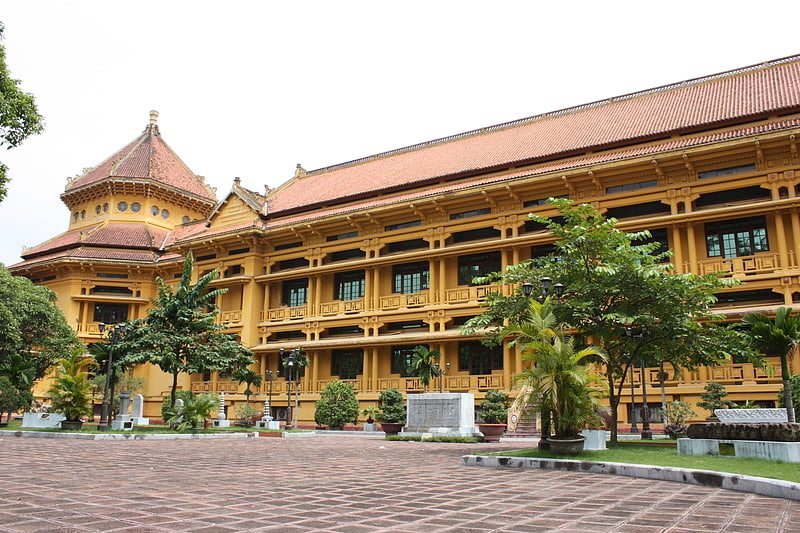
Also known as: Bảo tàng Lịch sử Việt Nam
Exhibits on prehistory and modern times. The Vietnam National Museum of History is in the Hoan Kiem district of Hanoi, Vietnam. The museum building was an archaeological research institution of the French School of the Far East under French colonial rule of 1910, was extensively refurbished in 1920. It was redesigned between 1926 and 1932 by architect Ernest Hébrard. The museum was acquired by the Government of Vietnam in 1958 and then the artifact collections were expanded to cover eastern arts and national history.
The museum highlights Vietnam's prehistory (about 300,000–400,000 years ago) up to the August 1945 Revolution. It has over 200,000 exhibits displayed covering items from prehistory up to the 1947 revolution and founding of the Democratic Republic of Vietnam, arranged in five major sections.[21]
Address: 1 Tràng Tiền, Hanoi
Perfume Pagoda

Also known as: Chùa Hương
Buddhist temple in Vietnam. The Perfume Pagoda is a vast complex of Buddhist temples and shrines built into the limestone Hương Tích mountains. It is the site of a religious festival which draws large numbers of pilgrims from across Vietnam. The centre of the Hương Temple lies in Hương Sơn Commune, Mỹ Đức District, former Hà Tây Province. The centre of this complex is the Perfume Temple, also known as Chùa Trong, located in Hương Tích Cave.[22]
Ho Chi Minh Museum

Also known as: Bảo tàng Hồ Chí Minh
Exhibits related to Ho Chi Minh. The Ho Chi Minh Museum is located in Hanoi, Vietnam. Constructed in the 1990s, it is dedicated to the late Vietnamese leader Ho Chi Minh and Vietnam's revolutionary struggle against foreign powers.
Ho Chi Minh museum is located in the Ho Chi Minh complex. The museum documents Ho Chi Minh's life, with 8 chronological exhibitions. The first one, from 1890 to 1910 modeled after his upbringing, hometown and youth. The second exhibit concerns the next ten years of his life, when Ho Chi Minh travelled the world seeking a means of freeing Vietnam from the restraints of colonialism.
The next three exhibits, covering Ho Chi Minh's life from 1920 to 1945, depict how he adapted the influence of Marxism and Leninism into the founding principles of the Vietnamese Communist Party, as well as addressing his continued pursuit of achieving independence for Vietnam. Exhibits 6-7 cover Ho Chi Minh's life from 1945 until his death in 1969. The final grouping of exhibits primarily focus on his status as a national hero and the finer details of his political life.
The museum consists of a collection of artifacts, miniatures, and various gifts gathered nationally and internationally. In addition to Vietnamese, the museum also provides descriptions written in English as well as French. Guided tours are also available upon request.[23]
Address: 19 Ngoc Ha St, 100000 Hanoi
Đền Đô
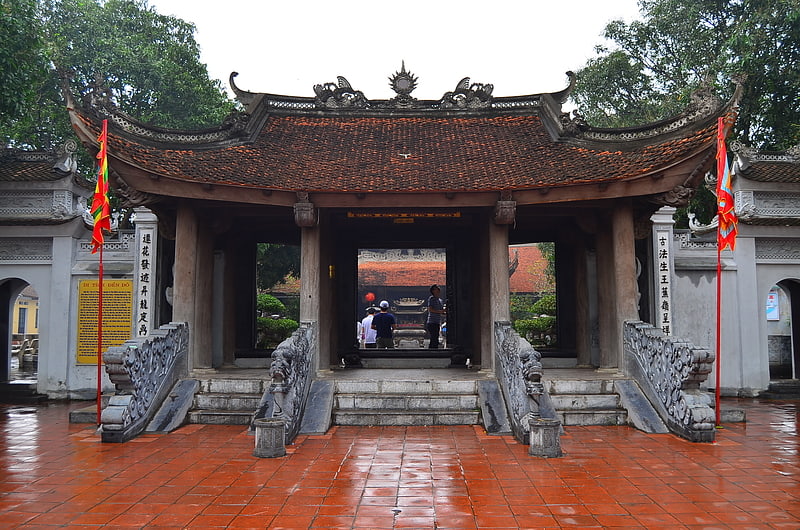
Also known as: Đền Lý Bát Đế
Place of worship in Tu Son, Vietnam. The Lý Bát Đế Temple or Đô Temple, formal Buddhist name Cổ Pháp Điện, is a temple near Hanoi of which the central section was built in 1028 on the death of Lý Thái Tổ, and the complex enlarged as seven of his descendant Lý Dynasty emperors were also buried at the shrine – Lý Bát Đế means "Eight Lý Emperors." Traditionally the shrine serves for ancestor worship of the eight emperors. It is located in Đình Bảng Commune, Từ Sơn District, in the Red River Delta province of Bắc Ninh. Another national monument, Đình Bảng communal house, is adjacent.[24]
Address: Đình Bảng, Hanoi
Chùa Bút Tháp
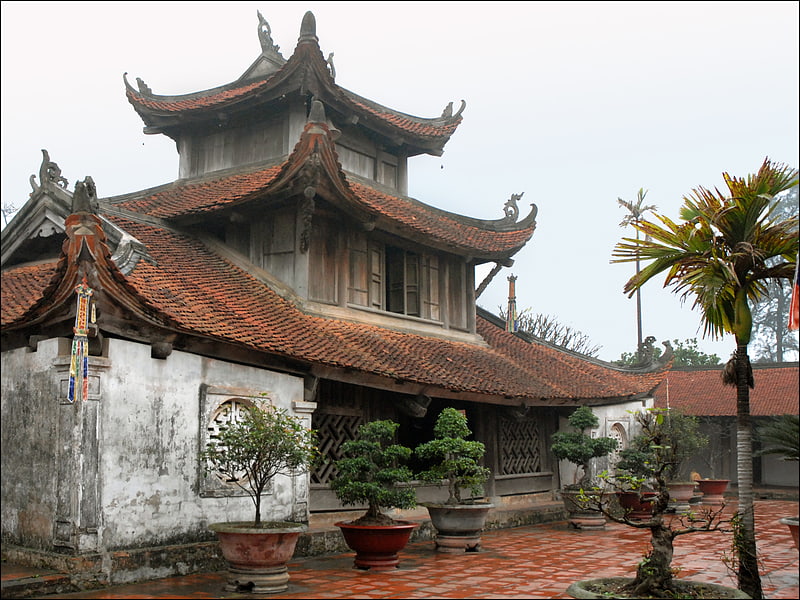
Temple in Vietnam. Bút Tháp Temple is a Buddhist temple located near the dyke of the Đuống River, Thuận Thành District, Bắc Ninh Province, Vietnam. The temple is also popularly called Nhan Thap Temple. The temple was built in the 13th century. The temple houses the biggest Avalokiteśvara statue with one thousand eyes and a thousand arms. But Thap Temple is one of the most famous temples in Viet Nam. Inside, there are various valuable ancient objects and statues, which are considered to be Vietnamese masterpieces of 17th-century wood carving. During the same time the temple had become famous for the venerable abbot and Zen master Chuyet Chuyet 1590 - 1644.
The complex has 10 buildings spreading for 100 meters from the three-entrance gate to the bell-tower and back house. Inside the temple are more than 50 statues of different sizes including the Triad Buddha, Manjusri (Van Thu) on a blue lion and Samantabhadra (Pho Hien) on a white elephant. The most remarkable is the thousand-handed and thousand-eyed Guanyin, which is described as a sculptural masterpiece of Vietnam.
The architecture, sculpture and decoration of the temple were exclusively confined to the 17th century, so it was the best intact and typical example of Vietnam’s classical Buddhist art.[25]
Thiền Quang Lake
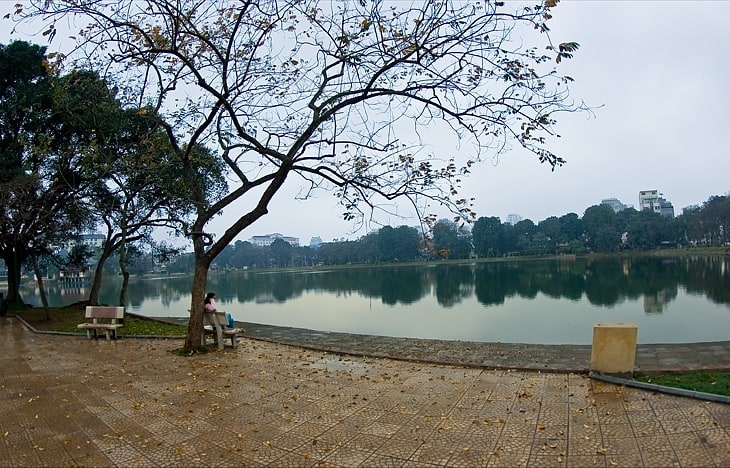
Also known as: Hồ Thiền Quang
Lake in Vietnam. Halais Lake is a lake in Hanoi, Vietnam, located next to Nguyễn Du Street, which used to be named "Rue Halais" under the French, hence the name "Halais". According to Vietnamese sources, it should be spelled "Halais Lake", the French name for the lake called "Hồ Thiền Quang" in Vietnamese.[26]
Address: Trần Nhân Tông, Hanoi
Trúc Bạch Lake
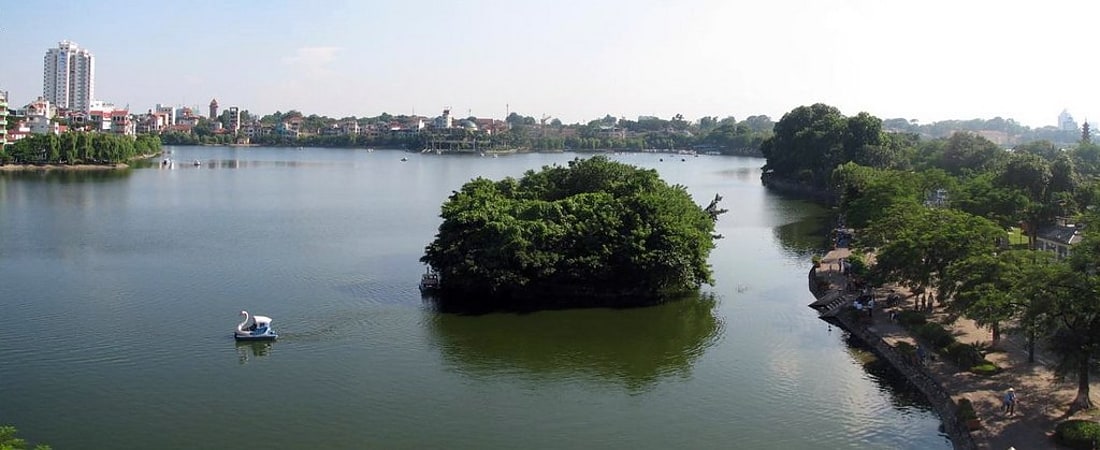
Also known as: Hồ Trúc Bạch
Lake with a Vietnam War monument. Trúc Bạch Lake is one of the many lakes in the city of Hanoi, the capital of Vietnam. It is known outside Vietnam as the site where future United States politician John McCain landed during the Vietnam War after being shot down.
Trúc Bạch Lake is located northwest of Hanoi's Old Quarter, immediately adjacent to the eastern shore of the city's largest lake, the West Lake (Hồ Tây), a former branch of the Red River whose west bank is nearby. Trúc Bạch Lake was separated from the West Lake by the construction of a narrow dike (Cổ Ngư, "reinforcement") in the 17th century to allow raising fish. The inhabitants of the Truc Yen Village, located on the south shore of the newly formed lake, were in the business of making bamboo blinds and hence cultivated a small variety of bamboo. In 1957 and 1958, major Thanh Niên Road was built between the lakes. In 1730s, the Trịnh Lord Trịnh Giang had Trúc Lâm Palace constructed on the lake shore. The building first served as a pleasure palace but was later converted into a prison for royal concubines found guilty of crime. The silk they produced, known as "Bamboo Village Silk" became famous for its beauty.
The lake front is open only along Thanh Niên Road, the other sides are occupied by houses and residential streets. The lake is among the most seriously polluted in Hanoi. Nearby historical sites include: Quán Thánh Temple to the southwest of the lake, Châu Long Pagoda to the east, An Trì Temple (dedicated to the worship of a hero from the war against the Chinese Yuan Dynasty) on Phó Đức Chính Street, and Cẩu Nhi temple on a small hill near the northern corner of the lake.[27]
Address: Thanh Niên, Hanoi
Fine Arts Museum
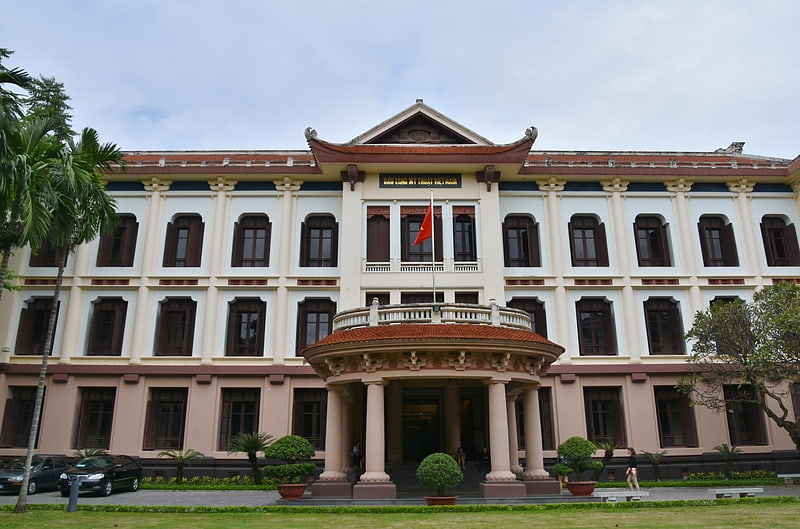
Also known as: Bảo tàng Mỹ thuật Việt Nam
Museum in Hanoi, Vietnam. The Vietnam National Museum of Fine Arts is located in Hanoi, Vietnam. It is a museum showcasing Vietnam's fine arts from a range of historical periods. It is the country's primary art museum, the second being the smaller Ho Chi Minh City Museum of Fine Arts.
The Museum exhibits Vietnam's fine arts from the Ancient time till the Modern time. Much of the 20th Century art presented in the museum is concerned with folk narratives of a nation in defence. As a collection it draws on themes of martyrdom, patriotism, military strategy and overcoming enemy incursion.
The museum presents a small collection of late 20th and early 21st Century painting, including works by artists exploring abstraction and abstract impressionism, giving greater attention to the individualist artist.
The site, 66 Nguyễn Thái Học Street, was selected by painter Nguyễn Đỗ Cung in 1963. The building, built in 1937, was an abandoned Catholic girl's boarding house. Next door at No. 65 was an artists' colony.[28]
Address: 66 Nguyen Thai Hoc St, 10000 Hanoi
Cổ Loa Citadel
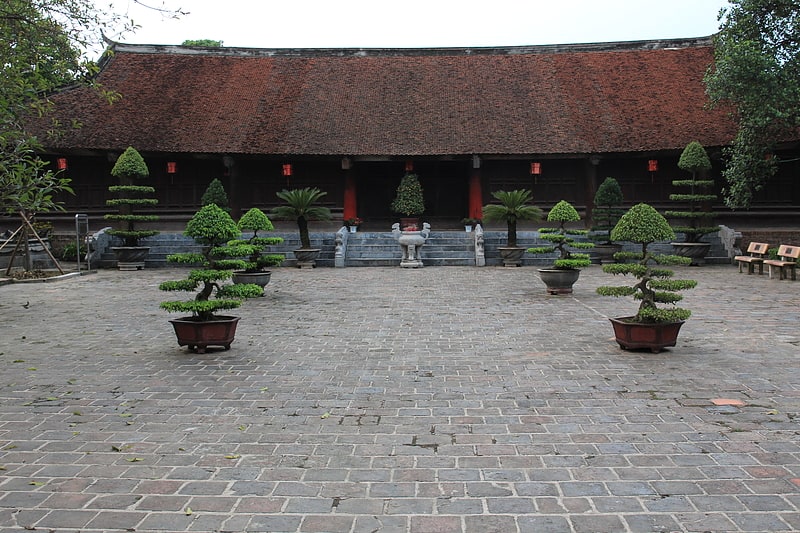
Also known as: Cổ Loa
Historical landmark in Vietnam. Cổ Loa Citadel is an important fortified settlement and archaeological site in present-day Hanoi's Dong Anh district, roughly 17 kilometers north of present-day Hanoi, in the upper plain north of the Hong River. Various relics of the Bronze Age Phung Nguyen culture and Dong Son culture have been found in Cổ Loa, although it was later established as the capital of Âu Lạc Kingdom during the 3rd century BCE. It might be the first political center of the Vietnamese civilization. The settlement’s concentric walls resemble a snail’s shell; it had an outer embankment covering 600 hectares.[29]
Address: Cổ Loa, 10000 Đông Anh
Flag Tower of Hanoi
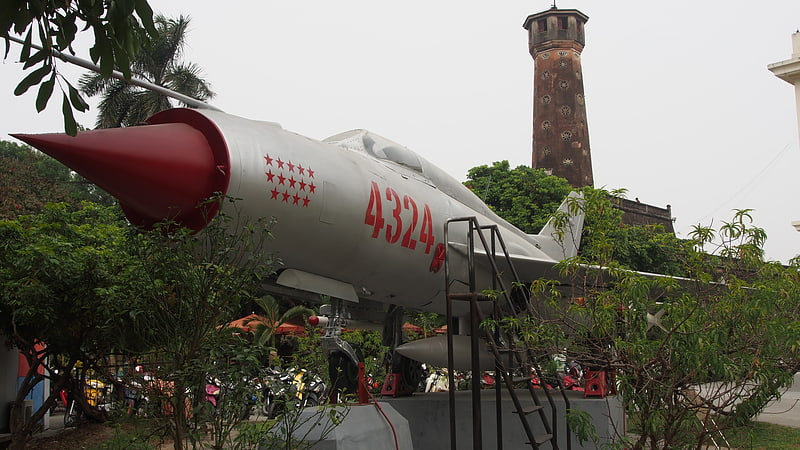
Also known as: Cột cờ Hà Nội
Historically significant flag tower. The Flag Tower of Hanoi is a tower in Hanoi, Vietnam, which is one of the symbols of the city and once a part of the Hanoi Citadel, a World Heritage Site. Its height is 33.4 m.[30]
Address: Vietnam Military History Museum, Hanoi
St. Joseph's Cathedral
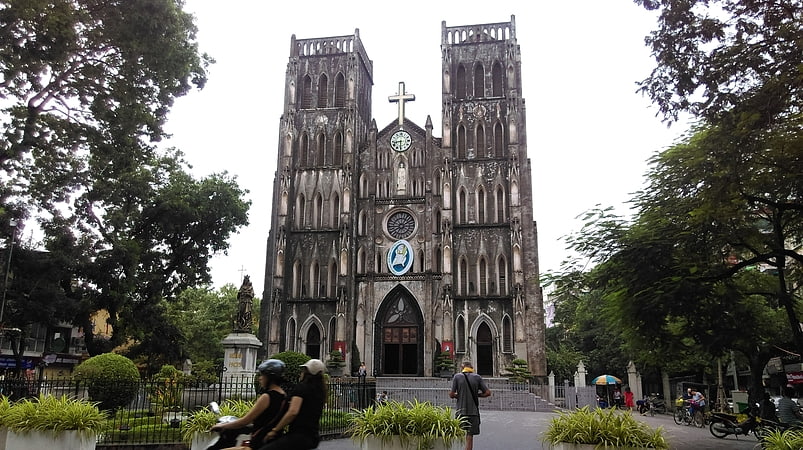
Also known as: Nhà thờ Lớn Hà Nội
Grand Catholic seat dating to 1886. St. Joseph's Cathedral is a church on Nha Chung Street in the Hoàn Kiếm District of Hanoi, Vietnam. It is a late 19th-century Gothic Revival church that serves as the cathedral of the Roman Catholic Archdiocese of Hanoi. The cathedral was named after Joseph, the patron saint of Vietnam.
Construction began in 1886, with the architectural style described as resembling Notre Dame de Paris. The church was one of the first structures built by the French colonial government in Indochina when it opened in December 1886. It is the oldest church in Hanoi.
The cathedral conducts mass several times during the day. For Sunday evening mass at 6:00 PM, large crowds spill out into the streets. The prayer hymns are broadcast and Catholics who are unable to enter the cathedral congregate in the street and listen to hymns.[31]
Address: 40 Nhà Chung, 100000 Hoàn Kiếm
Đống Đa District
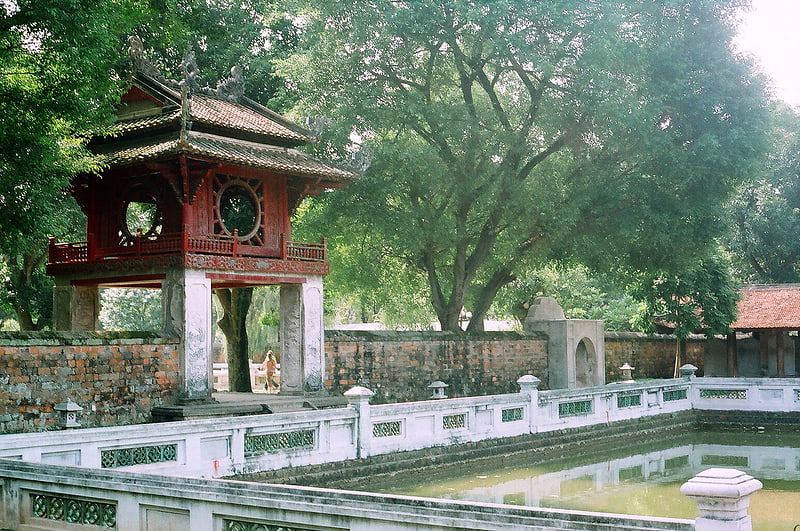
Đống Đa is one of the four original urban districts of Hanoi, the capital city of Vietnam. It is bordered by Ba Đình to the north, Hoàn Kiếm to the northeast, Hai Bà Trưng to the east, Thanh Xuân to the south, and Cầu Giấy to the west. The district currently has 21 wards, covering a total area of 9.95 square kilometers. It is the most populous district in Hanoi. As of 2017, there were 420900 people residing in the district, the population density is 42302 inhabitants per square kilometer, 18 times higher than the overall density of Hanoi. Dong Da district is home to various enterprises and many of Vietnam's most prestigious universities such as Hanoi Medical University, Foreign Trade University, University of Transport and Communications, Thuyloi University.
Dong Da district has a large number of monuments and relics, including Temple of Literature (Văn Miếu), a cultural symbol of the city. The district is also where the Battle of Ngọc Hồi-Đống Đa between Tây Sơn dynasty and the Qing dynasty, one of the greatest victories in Vietnamese military history, ended.[32]
Presidential Palace Historical Site
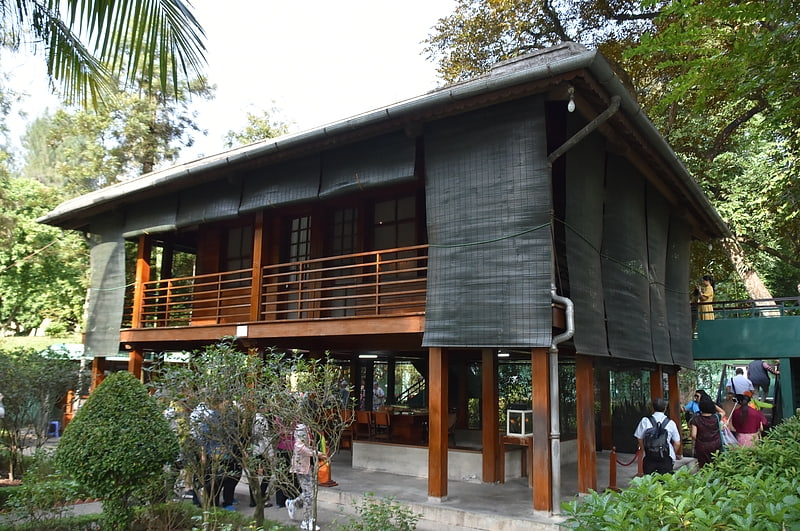
Also known as: Khu di tích Phủ Chủ tịch
Presidential Palace Historical Site, which is located in Hanoi, Vietnam, is the place where Ho Chi Minh lived and worked in most of his revolutionary life. This site was listed by the Ministry of Culture and Information of Vietnam in 1975.[33]
National Assembly Building of Vietnam
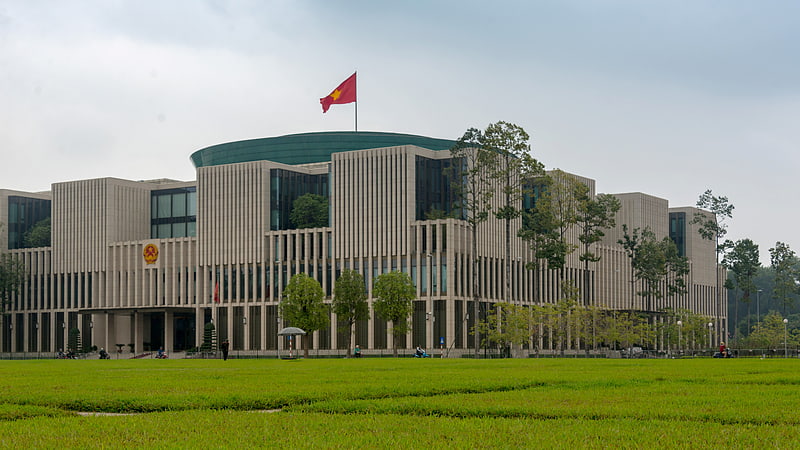
The National Assembly Building of Vietnam, also known as the New Ba Đình Hall, is a public building located on Ba Đình Square across from the Ho Chi Minh Mausoleum in Hanoi, Vietnam. Construction started on October 12, 2009 and finished on October 20, 2014. The building is used by the National Assembly of Vietnam for its sessions and other official functions.
This building is the largest and most complex office building built in Vietnam after the reunification of the country. The Building covers an area of 63,000 m2, and is 39 m in height. The building can accommodate 80 separate meetings with more than 2,500 people at the same time.
The old Ba Đình Hall was demolished in 2008 to make room for a new parliament house. However, archaeological remains of the old imperial city of Hanoi, Thăng Long, were found on the site and therefore the construction of a new building was delayed.
The proposed project took 15 years (1999–2014) from the initial concept to the inauguration. The project attracted attention and debates in the country's mass media concerning the construction site and conservation of Ba Đình Hall. The project led to the largest archaeological excavations in Vietnam at the site of Imperial Citadel of Thăng Long. The German architecture design consultant company, gmp International GmbH, was awarded the Vietnam's National Architecture Award by the Vietnam Architect Society in 2014.[34]
Address: 2 Đường Độc Lập, Hanoi
Hanoi Ceramic Mosaic Mural

Also known as: Con đường Gốm sứ
Tourist attraction in Vietnam. Hanoi Ceramic Mosaic Mural, or Hanoi Ceramic Road, is a ceramic mosaic mural along the walls of the Red River dike system in the city of Hanoi, northern Vietnam.
With a length of about 6.5 kilometres (4.0 mi), the 'Ceramic Road' is one of the major projects that were developed on the occasion of the Millennial Anniversary of Hanoi.[35]